Small overlap front
The small overlap front evaluation consists of a driver-side and a passenger-side component. If the results of the two evaluations differ, then the combined small overlap rating is equal to the lower rating.
Driver-side
- Rating applies to 2020-25 models
Tested vehicle: 2020 Subaru Legacy 2.5i Premium 4-door 4wd
The Subaru Legacy was redesigned for the 2020 model year. Driver-side small overlap frontal ratings are assigned by the Institute based on a test conducted by Subaru.
The driver-side small overlap frontal crash test ratings also apply to the station wagon version of the Legacy, known as the Outback, also redesigned for 2020.
| Evaluation criteria | Rating |
|---|---|
| Overall driver-side evaluation | |
| Structure and safety cage | |
| Driver injury measures | |
| Head/neck | |
| Chest | |
| Hip/thigh | |
| Lower leg/foot | |
| Driver restraints and dummy kinematics | |
Passenger-side
- Rating applies to 2020-25 models
Tested vehicle: 2020 Subaru Legacy 2.5i Premium 4-door 4wd
The Subaru Legacy was redesigned for the 2020 model year. Passenger-side small overlap frontal ratings are assigned by the Institute based on a test conducted by Subaru.
The passenger-side small overlap frontal crash test ratings also apply to the station wagon version of the Legacy, known as the Outback, also redesigned for 2020.
| Evaluation criteria | Rating |
|---|---|
| Overall passenger-side evaluation | |
| Structure and safety cage | |
| Passenger injury measures | |
| Head/neck | |
| Chest | |
| Hip/thigh | |
| Lower leg/foot | |
|
Passenger restraints and dummy kinematics
The dummy’s head contacted the right side of the frontal airbag but began to move into the gap between the frontal and side curtain airbags, leaving the head vulnerable to contact with forward structure. The inflated side curtain airbag has sufficient forward coverage to protect the head from contact with side structure and outside objects. | |
| Driver injury measures | |
| Head/neck | |
| Chest | |
| Hip/thigh | |
| Lower leg/foot | |
| Driver restraints and dummy kinematics | |
Moderate overlap front: original test
Rating applies to 2020-25 models
Tested vehicle: 2020 Subaru Legacy 2.5i Premium 4-door 4wd
The Subaru Legacy was redesigned for the 2020 model year. Moderate overlap frontal ratings are assigned by the Institute based on a test conducted by Subaru.
The moderate overlap frontal crash test ratings also apply to the station wagon version of the Legacy, known as the Outback, also redesigned for 2020.
| Evaluation criteria | Rating |
|---|---|
| Overall evaluation | |
| Structure and safety cage | |
| Driver injury measures | |
| Head/neck | |
| Chest | |
| Leg/foot, left | |
| Leg/foot, right | |
| Driver restraints and dummy kinematics | |
Moderate overlap front: updated test
Rating applies to 2023-25 models
Tested vehicle: 2023 Subaru Outback 4wd
The Subaru Outback was redesigned for the 2020 model year.
| Evaluation criteria | Rating |
|---|---|
| Overall evaluation | |
| Structure and safety cage | |
| Driver injury measures | |
| Head/neck | |
| Chest | |
| Thigh/hip | |
| Leg/foot | |
| Driver restraints and dummy kinematics | |
| Rear passenger injury measures | |
| Head/neck | |
| Chest | |
| Thigh | |
|
Rear passenger restraints and dummy kinematics
| |
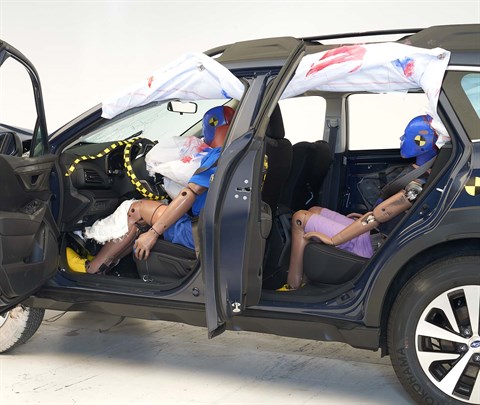
View of the vehicle after the crash showing the airbags and damage to the occupant compartment.
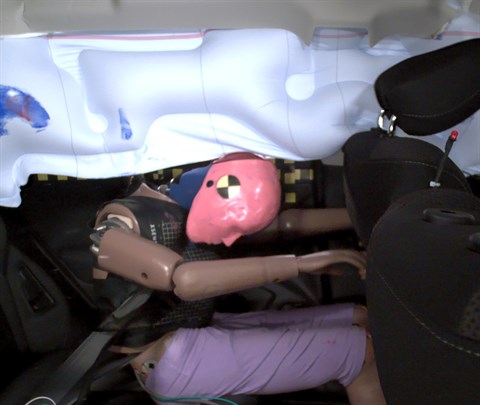
The rear passenger dummy's head approached the front seatback, which increases the risk of head injuries.
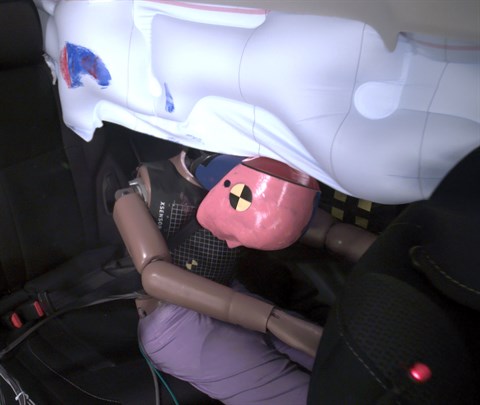
Rear passenger dummy injury values indicate a low risk of injury to the head or neck and chest. During the crash, the shoulder belt remained in an ideal position on the dummy’s chest.

The rear passenger dummy's lap belt moved from the ideal position on the pelvis onto the abdomen, increasing the risk of abdominal injuries.
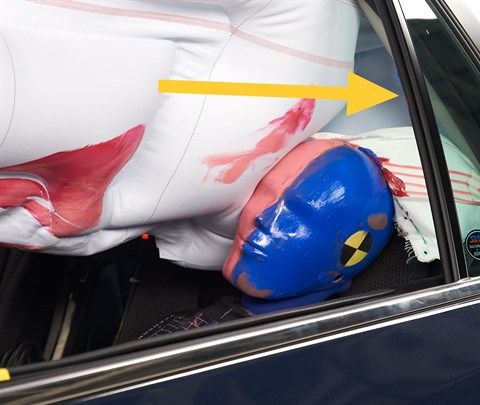
During rebound the rear passenger dummy's head moved outside of the side curtain airbag and contacted the rear window door trim. The head protection is inadequate and puts the head at risk of possible contact with outside objects.
Side: updated test
Rating applies to 2020-25 models
Tested vehicle: 2022 Subaru Outback Premium wagon 4wd
The Subaru Outback was redesigned for the 2020 model year.
| Evaluation criteria | Rating |
|---|---|
| Overall evaluation | |
| Structure and safety cage | |
| Driver injury measures | |
| Head/neck | |
| Torso | |
| Pelvis | |
| Driver head protection | |
| Rear passenger injury measures | |
| Head/neck | |
| Torso | |
| Pelvis | |
| Rear passenger head protection | |
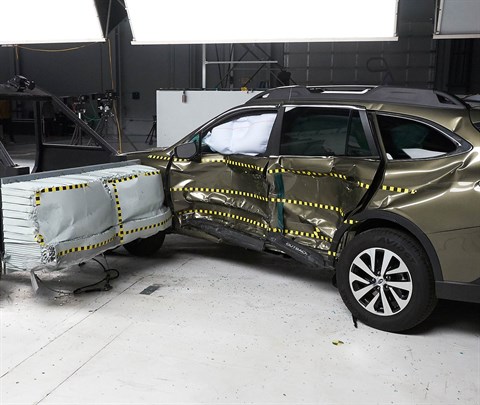
View of the vehicle just after the crash test.
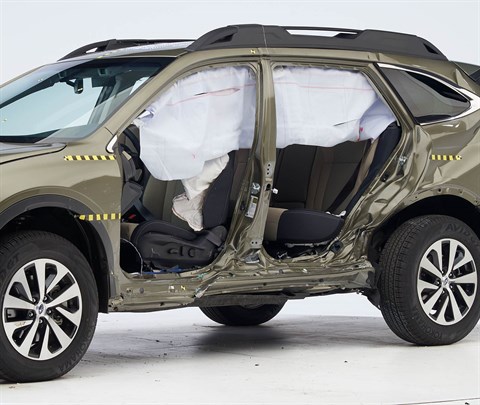
View of the vehicle after the crash with doors removed, showing the side airbags and damage to the occupant compartment.

Smeared greasepaint shows where the driver dummy's head was protected from being hit by hard structures by the side airbags.
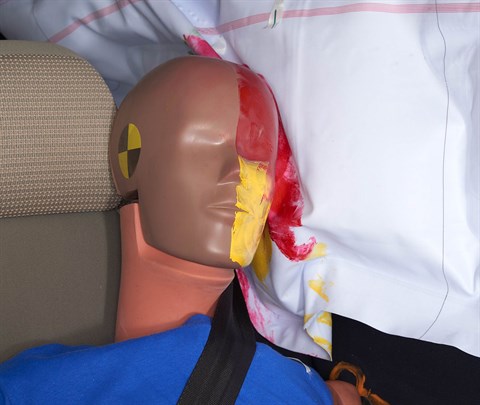
Smeared greasepaint shows where the rear passenger dummy’s head was protected by the side airbag.
Headlights
Trim level(s)
- All trims
| Evaluation criteria | Rating |
|---|---|
| Low-beam headlight type | LED projector |
| High-beam headlight type | LED projector |
| Curve-adaptive? | Yes |
| High-beam assist? | Yes |
|
Overall rating | |
| Distance at which headlights provide at least 5 lux illumination: | |
Low beams
On the straightaway, visibility was good on both sides of the road. On curves, visibility was good on the gradual left and both right curves and fair on the sharp left curve.
The low beams never exceeded glare limits.
High beams
On the straightaway, visibility was fair on the right side of the road and inadequate on the left side. On curves, visibility was good in all 4 tests.
High-beam assist compensates for some limitations of this vehicle's low beams on both left curves.
Front crash prevention: pedestrian
Seat belt reminders
Rating applies to 2022-25 models
| Evaluation criteria | Rating |
|---|---|
| Overall evaluation | |
| Front row | |
| Unbelted occupant alert (audible & visual) | |
| Initiation time | |
| Duration | Long enough (90+ seconds) |
| Volume | |
| Audio frequency | |
| Second row | |
| Startup status alert (visual) | |
| Initiation time | |
| Duration at least 60 seconds | |
| Belt disengaged alert (audible & visual) | |
| Initiation time | |
| Duration at least 30 seconds | |
| Volume | |
| Audio frequency | |
Child seat anchors
Rating applies to 2020-25 models
| Evaluation criteria | Rating |
|---|---|
| Overall evaluation | + extra LATCH positions |
| Vehicle trim | Premium |
| Seat type | cloth |
This vehicle has 2 rear seating positions with complete child seat attachment (LATCH) hardware.
It has 1 additional seating position with a tether anchor, a single lower anchor and the ability to borrow the second anchor from another position.
Note: When anchors are borrowed, they aren't available to use in their designated positions.
| Evaluation criteria | Rating |
|---|---|
| Overall evaluation | + extra LATCH positions |
| Vehicle trim | Premium |
| Seat type | cloth |
| Rating icon | Rating |
|---|---|
| G | Good |
| A | Acceptable |
| M | Marginal |
| P | Poor |
| Seating positions that rely on borrowed lower anchors or have only a tether anchor available are not rated. | |
thether anchor symbol | Tether anchor |
lower anchor symbol | Lower anchors |
| Lower anchor(s) can be borrowed from adjacent positions(s) | |
| No hardware available |
Details by seating position
| Position | Rating |
|---|---|
| 1 | |
| Tether anchor | |
| easy-to-find location | |
| no other hardware could be confused for anchor | |
| Lower anchors | |
| not too deep in seat | |
| not too much force needed to attach | |
| easy to maneuver around anchors | |
| 2 | |
| Tether anchor | |
| easy-to-find location | |
| no other hardware could be confused for anchor | |
| Lower anchors | |
| 1 dedicated anchor and 1 that can be borrowed from seat 1 | |
| not too deep in seat | |
| not too much force needed to attach | |
| easy to maneuver around anchors | |
| 3 | |
| Tether anchor | |
| easy-to-find location | |
| no other hardware could be confused for anchor | |
| Lower anchors | |
| not too deep in seat | |
| not too much force needed to attach | |
| easy to maneuver around anchors |
